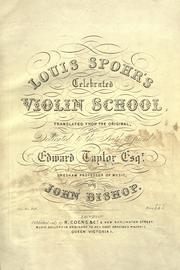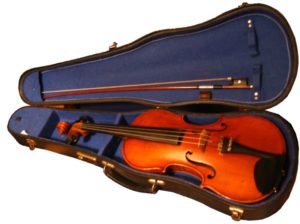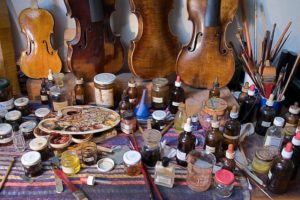For every violin student, from beginner to advanced, the purchase of a suitable instrument is a distinct milestone which can prove challenging. Your violin is your voice, and so must meet your expectations of tone as well as allowing development in technique and musical knowledge. A bad instrument is often much harder to play than a good one.
Most of us would love to own one of the million dollar Italian violins by a great maker, but given that they cost millions of pounds, the more pressing issue is how to find a violin that is just right for you at the price you can afford. This has been a subject of discussion for violin students for as long as the violin has been studied. In Louis Spohr’s Celebrated Violin School, an instruction manual on playing the violin published in 1832, Dr. Spohr notes:
“Every new Violin, even of the oldest wood, has, at first, a rough, unpleasant tone, and arrives only, at one of fine quality, after having been used for a number of years. Old instruments, therefore, which have been brought to perfection by constant use, are the only ones adapted for solo playing. Of these, (and, indeed, of all which have yet been manufactured,) the most esteemed are those of the three Cremona makers, Antonio Stradivario, Giuseppe Guanererio, and Nicolo Amati, who flourished in the latter half of the 17th and the beginning of the 18th century. The Violins of these makers unite in themselves, especially if well preserved, all the advantages of a good instrument, viz: a strong, full, and rich tone, perfect equality in the tones of each string; and a free emission of every sound from the lowest to the highest. They differ, however, in form, and in the characteristics of their tone.
These excellent instruments are dispersed throughout Europe, but, being mostly in the hands of rich amateurs, are scarce and dear; and as they yearly become more so, a young beginner will seldom meet with an opportunity of purchasing one.”

There are various questions you might consider when looking for a violin, whether it’s your first instrument or an upgrade.
How much should you pay?
For most people, the price you pay will depend to a large extent on what you can afford, but with the violin it is really worth remembering you get what you pay for. The price of an instrument will generally determine the quality. However, it can be possible find a cheaper violin that sounds good, and sound can be improved by the set-up of the bridge and sound post, quality strings and various other adjustments.
The value of a violin depends on several criteria: Who made it, where and when it was made and its condition. Because the violin has become an investment item in some circles, the sound of the instrument actually comes last on the list.
If you are really unsure about which violin to buy, consider renting first. Renting is a nice, low-commitment way to try out the instrument and get used to what you might look for in your own violin. You will also build up a relationship with the violin shop that will be useful when you want to buy.

Generally new violin outfits that cost less than £100 are not worth having. They often have so many problems that it’s likely you’ll be put off playing altogether. The parts are cheap and badly made, the bow won’t work, wobbling and skidding as it’s not properly balanced, the strings will be awful and the accessories will be cheap and poor quality. Some beginner sets can look like good value; you get a violin, a bow, spare strings, rosin and a case for what looks like a bargain. It’s likely that the hair will fall out of the bow in a short time, the bow stick will warp, the strings will sound so bad as to need replacing, and the violin will have cheap components which don’t work and a badly cut bridge that makes sound production much more difficult than it should be.
There are many brands of new violin set, many of which are only available online. These are not worth buying. Lark, Skylark, Cremona, Cecilio, Crystalcello, Mendini, Prodigy, Stentor, Palatino, Stagg, Breton, Doreli, Bellafina, Lazar, Persona and Florea are all cheap brands worth avoiding. Eastman sets are good, and violin shops will usually have their own brand of beginner violin too.
New student violins depreciate in value, particularly those that were cheap new. Another option could be a good quality used instrument. As Louis Spohr explained in his 1832 treatise, a violin that has been played for some years works better than a new instrument. A new violin always needs playing in, whereas an old one can provide a gratifying tone and help develop your playing right from the start.
The best way to buy is in person. Avoid eBay or Gumtree unless you can go and try the violin. Often instruments bought online need hundreds of pounds worth of repairs before they are playable.
Many of the older handmade instruments around are European violins made between 1880 and 1930; the most prolific time for violin making. These are known as trade, or factory made instruments. They are all handmade, but not by a single maker. One person would make the backs, one the tops and so on. It was fashionable for these to be aged to look like antique violins, and they often contain labels marked with the names of famous violin makers such as Stradivarius. These were never meant to be fakes; they were sold as copies. Just because they’re old doesn’t make them good. These factory instruments range from some of the worst violins around to some that are excellent for all but professional players. Never buy a violin because it’s labeled Stradivarius in the hope of netting a fortune. You won’t.
The best way to buy a violin, whether new or old, is from a reputable, specialist violin shop. It is normal to be able to take an instrument on trial for a week or two with no obligation to buy. It should also be possible to hear someone at the shop play the instruments for you so you can gauge how they sound from out front. A general music store is unlikely to employ a member of staff to show the instruments like this, but a violin shop will do. Take the violin to your lesson and ask your teacher’s advice too.

The Basic Milestones:
Don’t waste your money on anything less than £100. Save for a bit longer. It’s worth it. Really cheap violins are no good. Imagine buying any household appliance and going for the cheapest option. You wouldn’t expect it to last. The value toaster that blows up after a week; the washing machine that breaks down after a month; you just wouldn’t.
The better beginner violins are normally Chinese, and cost upwards of £250. You can get a really good beginner outfit for £500.
After you’ve played for a couple of years, you might look to move up to a violin for between £500 and £700. If you can’t afford to buy a better violin just yet, get a better bow first.
A violin that costs above £1000 will have a better quality of workmanship and wood. It will usually have a better sound and more evenness over the strings than a cheap model.
For handmade violins made by one maker, prices normally start at around £5000. These instruments would suit advanced players who were looking to study music. Once a violinist enters the profession and needs a really good violin, the sky is the limit. Professional instruments start at around £7000 and can go into the millions.
Tips on Choosing:
As already stated, buying a violin online is the worst way to do it. Not only do you have no guarantee of quality or workmanship, there is no chance to do the most important thing; see what it sounds like and feels like to play.
Look out for good quality materials…
Pegs: ebony, rosewood or boxwood. Be aware that some cheap Chinese instruments claim to have boxwood pegs but actually use a type of nut wood, which is of inferior quality. Pegs which are described as ‘ebonised’ (cheap wood painted black) are useless and should be avoided.
Varnish: On cheap violins the varnish is usually a thick, shiny, smooth polyurethane. This actually stops the instrument from vibrating as it is too hard. Look for a violin with a quality oil or spirit based varnish.
Strings: Look for minimum quality student strings, not thin Chinese factory strings. The Dogal Red Label and D’Addario Prelude brands are both decent beginner strings.
Bridge: The bridge should be cut to the correct thickness, height and spacing between strings. Bridges on basic beginner instruments are rather crudely cut, but remember the thicker and heavier the bridge, the more the sound will be damped. The feet of the bridge should fit the violin perfectly and the back of the bridge should be perpendicular with the belly of the instrument or slightly leaning back.
Bow: Always look for genuine horsehair, not synthetic hair.
Violin: Avoid a violin with too thick or thin a neck. The neck should sit comfortably in your hand when you play. Purfling (the inlaid detail around the edge of the violin) that is painted or scratched onto the instrument is not generally a sign of a quality violin, though some of the notable old makers used the technique of scratching on their instruments. On older instruments, check for cracks. A sound post crack can seriously deplete the value of a violin, and any crack will affect the sound. Look for an instrument that sounds evenly over all four strings with a clear, even response.

How to Buy a Violin
The best way to buy a violin is in person, not online. Even with kits that look identical, no two violins will sound or feel the same.
Choosing is not easy. You have to decide on your instrument based on your own personal sense of its feel and sound. If you aren’t yet proficient enough to try the violin yourself and judge the tone based on your ear, have somebody help you.
If you are considering buying an older instrument or one that has been repaired, ask the advice of an expert repairman. Even professional violinists often don’t know what to look for or what they’re looking at when they try an old violin, but while some repairs can have no adverse effect on tone, they may decrease the value of the instrument.
Try out the violin by playing scales and pieces you already know by memory. Long notes will give you a better idea of the evenness of tone than pieces with lots of fast notes. Decide your budget before you even get to the shop, so you know the range of instruments you will be looking at. You can either ask to try the instruments in order of price, cheapest first, or ask the shop to give you the instruments to try in a random order so you can make an unprejudiced judgment on the feel and sound. Try as many violins as you can, each time narrowing down your choice until you have selected your two favourite. Borrow these two for at least a week and play them to your teacher and as many other good players as you can. If you don’t like one of the strings, don’t discount the violin. A string is easily changed.
Don’t be intimidated by the violin shop. Even for seasoned players, going into a specialist violin shop can feel a little like going into a luxury car showroom with your lunch money. The staff are experts and they’re there to help. Ask your violin teacher which shops to try. If you live in a big city there’s likely to be a good violin shop, and if not, it’s worth the journey to find the best violin for you. Learning is accelerated by the purchase or hire of a violin that you really love playing, and playing becomes a real pleasure when you have the right violin.
Please visit our sponsors:
London String School - Tuition for Adult Learners in London
MusicLand - Creative Music Products for Teachers and Learners
Please visit our sponsors:
FiddlerShop.com - Quality instruments at an affordable price
London String School - Tuition for Adult Learners in London
MusicLand - Creative Music Products for Teachers and Learners
